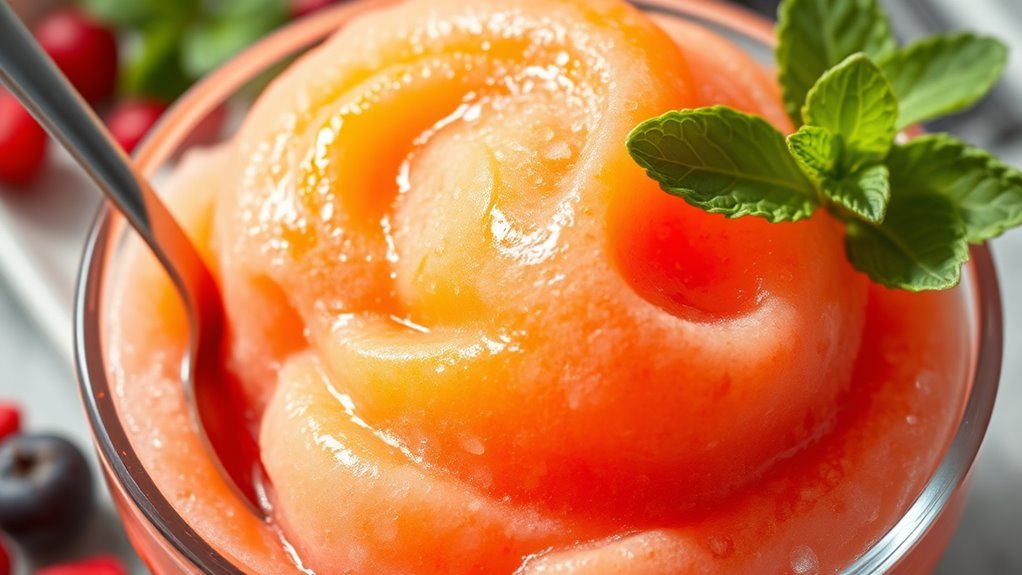Sherbet isn’t typically keto-friendly due to its high sugar content, which can range from 20-30 grams per serving. This makes it hard to fit within the low-carb limits of a ketogenic diet. However, you can consider alternatives like keto ice cream or homemade sherbet using low-carb ingredients. Portion control and mindful ingredient choices make enjoying sweet treats possible while adhering to keto principles. If you’re curious about more options and tips, there’s plenty more to explore.
Understanding the Keto Diet

Understanding the keto diet can be vital if you’re looking to reduce carbohydrate intake and boost fat consumption for weight loss or improved health. At its core, the keto diet revolves around key keto principles, emphasizing high fat, moderate protein, and very low carbohydrate consumption. This shift in macronutrients puts your body into a state of ketosis, where it efficiently burns fat for energy. However, it’s important to take into account dietary restrictions, as not all fats are created equal. Focus on healthy fats from sources like avocados, nuts, and olive oil, while avoiding processed foods. By understanding these fundamental concepts, you can navigate your food choices more freely, making informed decisions that align with your health goals. Additionally, embracing metabolic adaptation can enhance your body’s efficiency in utilizing fat for energy.
What Is Sherbet?

Sherbet is a frozen dessert that typically combines fruit puree, sugar, and water, creating a revitalizing treat that’s often lighter than ice cream. Its origins trace back to the Middle East, where it was first enjoyed as a invigorating drink. Over the years, sherbet has evolved into various types, each offering unique flavors and textures.
| Sherbet Type | Description |
|---|---|
| Fruit Sherbet | Made with fruit puree and sugar |
| Cream Sherbet | Contains milk or cream for richness |
| Italian Sorbetto | A denser, smoother style |
| Rainbow Sherbet | A colorful blend of flavors |
As you explore these delightful variations, you’ll find sherbet can be a fun, fruity addition to your dessert choices.
Common Ingredients in Sherbet

When considering sherbet, it’s crucial to understand its common ingredients, as they greatly impact its nutritional profile. You’ll find that sugar content varies widely, depending on the flavor and additives used. By exploring these elements, you can better assess whether sherbet fits into your dietary preferences.
Sugar Content Analysis
Although many people enjoy the invigorating taste of sherbet, it’s important to take a closer look at its sugar content, especially if you’re following a keto diet. Many traditional sherbets contain high amounts of sugar, which can kick you out of ketosis.
Here’s a quick analysis of common ingredients:
| Ingredient | Sugar Content (per serving) | Sugar Substitutes Used |
|---|---|---|
| Fruit Puree | 15g | Stevia |
| Corn Syrup | 20g | Erythritol |
| Artificial Flavor | 5g | Monk Fruit |
| Dairy Additives | 10g | Xylitol |
When checking nutritional labels, be wary of these ingredients. Opt for sherbets with lower sugar levels or those that utilize sugar substitutes to remain within your keto goals.
Flavor Variations Overview
What makes the flavor profile of sherbet so appealing? It’s the unique flavor combinations that surprise and delight your taste buds. Sherbet often showcases vibrant fruit flavors, like raspberry, lemon, or mango, which can be invigorating on a hot day. You might also find seasonal flavor inspirations, such as pumpkin spice in the fall or peppermint during the holidays. These flavors not only provide variety but also encourage creativity in your dessert choices. The balance of sweetness and tartness in sherbet creates a light and enjoyable treat, making it a favorite for many. As you explore different brands or homemade recipes, you’ll discover how these flavor variations contribute to the overall experience of enjoying sherbet.
Common Additives Explained
While enjoying the vibrant flavors of sherbet, it’s important to take into account the common additives that contribute to its texture and taste. These ingredients can vary, but understanding their functions helps you make informed choices:
- Stabilizers: Additive types like guar gum or xanthan gum help maintain texture and prevent ice crystals from forming.
- Emulsifiers: Ingredients such as soy lecithin guarantee a smooth consistency by blending water and fat.
- Flavor Enhancers: Natural or artificial flavors enhance the overall taste, making sherbet more enjoyable.
Being aware of these ingredient functions can empower you to choose sherbet that aligns with your dietary preferences, especially if you’re aiming for a keto-friendly option. Enjoy your treat, but knowledge is key!
Carb Content in Traditional Sherbet
When considering traditional sherbet, it’s important to examine its sugar content, which can greatly impact its carbohydrate levels. A typical serving size often contains more carbs than you might expect, primarily due to the added sugars. Understanding these factors can help you make informed choices about incorporating sherbet into your diet.
Sugar Content Analysis
Although many people enjoy the invigorating taste of sherbet, its sugar content can raise concerns for those following a ketogenic diet. Traditional sherbet often contains high amounts of sugar, which can greatly impact your carb intake. When analyzing its sugar content, consider the following:
- A typical serving can contain 20-30 grams of sugar.
- This sugar primarily comes from added sweeteners, not just fruit.
- Using sugar substitutes or natural sweeteners can help reduce carb content.
When making your choice, it’s essential to be aware of these sugar levels and consider alternatives. Additionally, understanding net carbs is crucial for ensuring you stay within your daily carb limits. By opting for sherbets made with sugar substitutes or natural sweeteners, you might find a more keto-friendly option that still satisfies your cravings without derailing your dietary goals.
Serving Size Impact
The serving size of traditional sherbet greatly influences its carbohydrate content, making it crucial for those on a ketogenic diet to pay attention. A typical serving, often around half a cup, can contain anywhere from 15 to 25 grams of carbs, depending on the brand and ingredients. If you’re aiming for a low-carb lifestyle, practicing portion control is essential. By limiting your serving size, you can enjoy a small amount without exceeding your daily carb limit. Balance is key; savoring a modest portion might allow you to indulge occasionally without derailing your keto goals. Always check nutrition labels to make informed decisions, keeping your dietary preferences in mind while enjoying your favorite treats.
Keto-Friendly Sherbet Alternatives
If you’re on a keto diet and craving a sweet, rejuvenating treat, there are several alternatives to traditional sherbet that can satisfy your taste buds without derailing your nutritional goals. You can indulge in these keto-friendly options, which are low in carbs and packed with flavor:
- Keto Ice Cream: Made with heavy cream and low-carb sweeteners, it’s a delicious alternative to sherbet.
- Frozen Greek Yogurt: Opt for unsweetened varieties and add your favorite low-carb sweetener for a creamy treat.
- Smoothie Bowls: Blend your choice of low-carb fruits like berries with coconut milk for a revitalizing dessert.
These keto desserts not only keep your carb intake in check but also allow you to enjoy low carb sweets guilt-free! Additionally, using natural sugar substitutes can enhance the sweetness of your treats while maintaining a low carbohydrate profile.
How to Make Your Own Keto Sherbet
Making your own keto sherbet is easier than you might think, especially when you can control the ingredients to keep it low in carbs. Start with keto-friendly ingredients like unsweetened almond milk or coconut milk as a base. Sweeten it with a low-carb sweetener like erythritol or stevia. For flavoring, you can use homemade flavoring by blending fresh or frozen berries, citrus juice, or even extracts like vanilla or mint. Simply mix your chosen ingredients, pour them into a container, and freeze for a few hours. Stir occasionally to achieve a smooth texture. This way, you can enjoy a revitalizing treat that aligns with your keto lifestyle while experimenting with flavors that tantalize your taste buds! Additionally, remember that tracking carbohydrate content is crucial to maintaining your keto goals while indulging in sweet treats.
Store-Bought Options to Consider
Wondering what store-bought options are available for keto-friendly sherbet? You’ll be pleased to know that certain brands cater to your keto lifestyle while still offering that invigorating taste. When exploring store-bought options, always check the nutritional labels to verify they fit your dietary needs. Here are a few brands you might consider:
Explore delicious store-bought keto-friendly sherbet options that satisfy your cravings while keeping your diet on track. Always check the labels!
- Enlightened: Their sherbet has lower carbs and uses natural sweeteners.
- Rebel: Known for their keto-friendly desserts, they offer flavors with minimal sugars.
- Nubocha: This brand focuses on vegan options, often featuring fewer carbs and no added sugars.
These store bought brands allow you to indulge in a tasty treat without compromising your keto goals. Just remember to read those nutritional labels carefully!
Tips for Enjoying Sherbet on a Keto Diet
While enjoying sherbet on a keto diet might seem challenging, there are practical tips to help you indulge without derailing your goals. Start by focusing on portion control; a small serving can satisfy your sweet tooth without exceeding your carb limits. Consider making your own sherbet at home using low-carb sweeteners and fresh fruit, giving you complete control over the ingredients. When it comes to sherbet toppings, opt for keto-friendly choices like unsweetened coconut flakes, chopped nuts, or a drizzle of sugar-free chocolate. These additions can enhance flavor without adding excessive carbs. Remember, moderation is key. By following these tips, you can enjoy sherbet while staying committed to your keto lifestyle.
Frequently Asked Questions
Can Sherbet Be Part of a Low-Carb Diet?
Sherbet can be part of a low-carb diet, but it’s important to watch portions. Did you know that some commercial sherbets contain up to 30 grams of sugar per serving? Instead, consider sherbet alternatives like sugar-free sorbets or homemade versions using low-carb sweeteners. You can also explore other low-carb desserts that satisfy your sweet tooth without derailing your diet. Balancing treats while staying mindful of carbs can give you freedom in your choices.
What Sweeteners Are Safe for Keto Sherbet?
When making keto sherbet, you can safely use natural sweeteners like stevia, erythritol, or monk fruit as sugar alternatives. These options provide sweetness without the carbs that traditional sugars carry, allowing you to enjoy a revitalizing treat without compromising your diet. Always check ingredient labels, as some sweeteners can have hidden carbs or fillers. Experimenting with these alternatives can help you create a delicious, keto-friendly sherbet that satisfies your cravings.
How Do I Calculate Net Carbs in Sherbet?
To calculate net carbs in sherbet, subtract the fiber content and sugar alcohols from the total carbohydrates. Did you know that some commercial sherbets can have up to 30 grams of sugar per serving? This high sugar content can greatly impact your daily carb limit. So, always check the nutrition label carefully. By focusing on the net carbs, you can enjoy a treat without straying too far from your goals!
Is Homemade Sherbet Healthier Than Store-Bought?
Yes, homemade sherbet can be healthier than store-bought options. When you make it yourself, you control the ingredient quality, allowing you to avoid preservatives and artificial flavors. Homemade benefits also include the ability to use fresh fruits and natural sweeteners, which can enhance nutritional value. While store-bought varieties may be convenient, they often contain added sugars and unhealthy additives. So, if you’re seeking a healthier option, consider whipping up your own sherbet!
Can I Freeze Keto-Friendly Sherbet for Later Use?
Yes, you can freeze keto-friendly sherbet for later use! To guarantee the best texture, store it in an airtight container, leaving some space for expansion. When you’re ready to enjoy it, let it sit at room temperature for a few minutes before scooping. Using proper freezing techniques helps maintain the flavor and consistency, allowing you to indulge guilt-free whenever you want. Just remember, homemade might be healthier than store-bought options!


